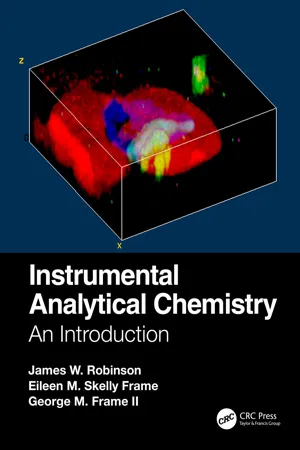
Instrumental Analytical Chemistry
An Introduction
- 902 pages
- English
- ePUB (mobile friendly)
- Available on iOS & Android
Instrumental Analytical Chemistry
An Introduction
About this book
Analytical chemistry today is almost entirely instrumental analytical chemistry and it is performed by many scientists and engineers who are not chemists. Analytical instrumentation is crucial to research in molecular biology, medicine, geology, food science, materials science, and many other fields. With the growing sophistication of laboratory equipment, there is a danger that analytical instruments can be regarded as "black boxes" by those using them. The well-known phrase "garbage in, garbage out" holds true for analytical instrumentation as well as computers. This book serves to provide users of analytical instrumentation with an understanding of their instruments.
This book is written to teach undergraduate students and those working in chemical fields outside analytical chemistry how contemporary analytical instrumentation works, as well as its uses and limitations. Mathematics is kept to a minimum. No background in calculus, physics, or physical chemistry is required. The major fields of modern instrumentation are covered, including applications of each type of instrumental technique.
Each chapter includes:
- A discussion of the fundamental principles underlying each technique
- Detailed descriptions of the instrumentation
- An extensive and up-to-date bibliography
- End of chapter problems
- Suggested experiments appropriate to the technique where relevant
This text uniquely combines instrumental analysis with organic spectral interpretation (IR, NMR, and MS). It provides detailed coverage of sampling, sample handling, sample storage, and sample preparation. In addition, the authors have included many instrument manufacturers' websites, which contain extensive resources.
Frequently asked questions
- Essential is ideal for learners and professionals who enjoy exploring a wide range of subjects. Access the Essential Library with 800,000+ trusted titles and best-sellers across business, personal growth, and the humanities. Includes unlimited reading time and Standard Read Aloud voice.
- Complete: Perfect for advanced learners and researchers needing full, unrestricted access. Unlock 1.4M+ books across hundreds of subjects, including academic and specialized titles. The Complete Plan also includes advanced features like Premium Read Aloud and Research Assistant.
Please note we cannot support devices running on iOS 13 and Android 7 or earlier. Learn more about using the app.
Information
Concepts of Instrumental Analytical Chemistry1
1.1 Introduction: What is Instrumental Analytical Chemistry?
Table of contents
- Cover
- Half Title
- Title Page
- Copyright Page
- Contents
- Abbreviations and Acronyms Index
- Preface
- Authors
- Acknowledgments
- Chapter 1 Concepts of Instrumental Analytical Chemistry
- Chapter 2 Introduction to Spectroscopy
- Chapter 3 Visible and Ultraviolet Molecular Spectroscopy
- Chapter 4 Infrared, Near-Infrared, and Raman Spectroscopy
- Chapter 5 Magnetic Resonance Spectroscopy
- Chapter 6 Atomic Absorption Spectrometry
- Chapter 7 Atomic Emission Spectroscopy
- Chapter 8 X-ray Spectroscopy
- Chapter 9 Mass Spectrometry
- Chapter 10 Principles of Chromatography
- Chapter 11 Gas Chromatography
- Chapter 12 Chromatography with Liquid Mobile Phases
- Chapter 13 Electroanalytical Chemistry
- Chapter 14 Thermal Analysis
- Index